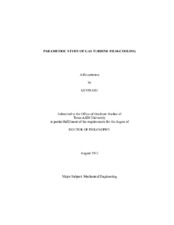| dc.description.abstract | In this study, the film-cooling effectiveness in different regions of gas turbine blades was investigated with various film hole/slot configurations and mainstream flow conditions. The study consisted of three parts: 1) turbine blade span film-cooling, 2) turbine platform film-cooling, and 3) blade tip film-cooling. Pressure sensitive paint (PSP) technique was used to get the conduction-free film-cooling effectiveness distribution. Film-cooling effectiveness is assessed in terms of cooling hole geometry, blowing ratio, freestream turbulence, and coolant-to-mainstream density ratio.
Blade span film-cooling test shows that the compound angle shaped holes offer better film effectiveness than the axial shaped holes. Greater coolant-to-mainstream density ratio prevents coolant to lift-off. Higher freestream turbulence causes effectiveness to drop everywhere except in the region downstream of suction side. Results are also correlated with momentum flux, compound shaped hole has the greatest optimum momentum flux ratio, and then followed by axial shaped hole, compound cylindrical hole, and axial cylindrical hole.
For platform purge flow cooling, the stator-rotor gap was simulated by a typical labyrinth-like seal. Two different film-cooling hole geometries, three blowing ratios and density ratios, and two freestream turbulence are examined. Results showed that the shaped holes present higher film-cooling effectiveness and wider film coverage than the cylindrical holes, particularly at higher blowing ratios. Moreover, the platform film-cooling effectiveness increases with density ratio but decreases with turbulence intensity.
The blade tip study was performed in a blow-down flow loop. Results show that a blowing ratio of 2.0 is found to give best results on the tip floor. Lift-off of the coolant jet can be observed for the holes closer to the leading edge as blowing ratio increases from 1.5 to 2.0.
A stator vane suction side heat transfer study was conducted in a partial annular cascade. The heat transfer coefficients were measured by using the transient liquid crystal technique. At X/L=0.15, a low heat transfer region where transition occurs. The heat transfer coefficients increase toward the trailing edge as flow accelerates; a spanwise variation can be found at neat tip and hub portions due to passage and horseshoe vortices. | en |


